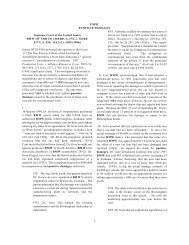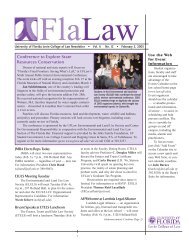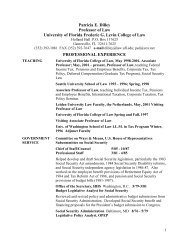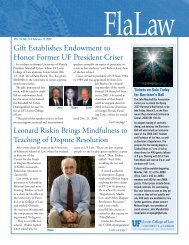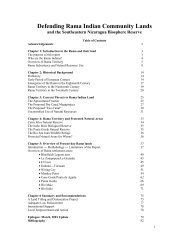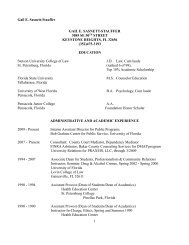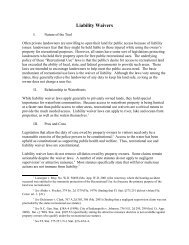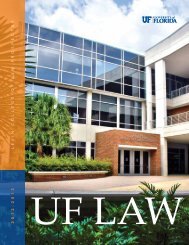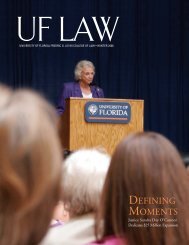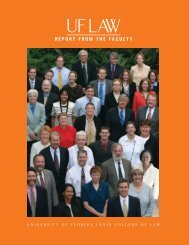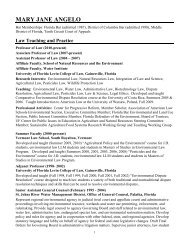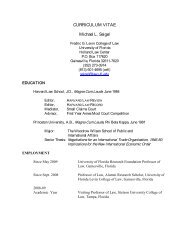Download Magazine - Levin College of Law - University of Florida
Download Magazine - Levin College of Law - University of Florida
Download Magazine - Levin College of Law - University of Florida
Create successful ePaper yourself
Turn your PDF publications into a flip-book with our unique Google optimized e-Paper software.
“The first lesson is this: Take it from me— every vote counts.” —AL GOREBitter words from AlGore, a man whoshould know. Gore,who won the majority<strong>of</strong> the nation’spopular vote in the2000 presidentialelection, ultimately conceded <strong>Florida</strong>’s 25electoral votes — and the White House— to George W. Bush after a landmarkdecision by the U.S. Supreme Court to end<strong>Florida</strong>’s vote recount. The final margin<strong>of</strong> victory for Bush in <strong>Florida</strong> consisted<strong>of</strong> 537 votes, .0002 percent <strong>of</strong> the state’snearly 6 million certified ballots.“What happened in 2000 is exactlywhat everyone feared, that it would godown to a few thousand votes or less,”said Stephen N. Zack (JD 71), one <strong>of</strong> theattorneys representing Gore following theelection and a partner in the Miami firmBoies, Schiller & Flexner. “I think onething important to look at from a historicalperspective is that there is virtually noelection that is free <strong>of</strong> problems. Whatusually occurs is that the margins are solarge that those problems do not becomesignificant. But when you have a verynarrow margin, they become very, verysignificant, and that’s what happened in<strong>Florida</strong> in 2000.”<strong>Florida</strong>’s 2000 presidential electionwas initially called in favor <strong>of</strong> Bushby 1,784 votes. This tiny margin <strong>of</strong>victory triggered statutorily-mandatedmachine recounts <strong>of</strong> ballots in all 67<strong>Florida</strong> counties, the results <strong>of</strong> whichnarrowed the margin to a Bush lead<strong>of</strong> little more than 300 votes. Bush’stenuous majority, coupled with votercomplaints <strong>of</strong> confusing butterfly ballotsand malfunctioning voting machines inseveral counties, compelled Gore, as hewas entitled to do under <strong>Florida</strong> law, toprotest the results in Broward, Dade,Palm Beach and Volusia counties. Hepressed for recounts in those counties <strong>of</strong>“undervotes” — ballots that did not showa valid legal selection during machinecounting, but which might demonstratevoter intent when examined manually.Gore’s decision to ask for manualrecounts in these heavily Democraticcounties, which many critics described as“strategic cherry-picking” <strong>of</strong> votes, kickedup a legal scrum <strong>of</strong> epic proportions. Afterweeks <strong>of</strong> litigation in <strong>Florida</strong>’s courts,examination <strong>of</strong> thousands <strong>of</strong> ballots withchads in various states <strong>of</strong> detachment,and media attention that characterized<strong>Florida</strong>’s election and state politics asnational jokes, the U.S. Supreme Courtintervened with a judgment — one likelyto be argued in law schools and livingrooms for generations — that effectivelyended the spectacle.“There can be no doubt that a majority<strong>of</strong> Americans voted for Al Gore to bepresident <strong>of</strong> the United States — that morepeople voted for Al Gore, or thought theywere voting for Al Gore, than for GeorgeBush,” said Zack, who is slated to be thenext president-elect <strong>of</strong> the American BarAssociation. “It definitely indicates thatelections are subject to human variables,and in a contested election that is razorthin, those human errors are going tocause problems.”‘FLORIDA CAN’T COUNT’Many people are still confused bythe series <strong>of</strong> events leading up to theU.S. Supreme Court’s intervention in<strong>Florida</strong>’s recount <strong>of</strong> the 2000 presidentialelection. By the time the nation’s highestcourt ended the litigation on Dec. 12,the battle had been raging in <strong>Florida</strong> for36 days and a dizzying number <strong>of</strong> suitsand countersuits had made the roundsthrough <strong>Florida</strong> and federal courts. Thecountry was obsessed with hangingchads, but <strong>Florida</strong> law did little to shedlight on how to discern the voter intentthey might reveal.“We’d tended to overlook theimportance <strong>of</strong> elections until the 2000presidential election, in which we realizedwe were using outdated equipment,machines and so on, particularly in thelarge populated counties,” said W. DexterDouglass (LLB 55), Gore’s lead <strong>Florida</strong>counsel and long-time state politico whopreviously served as general counselfor Gov. <strong>Law</strong>ton Chiles and chair<strong>of</strong> the <strong>Florida</strong> Constitution RevisionCommission. “The combination <strong>of</strong>antiquated voting systems and antiquatedvoting laws put us in a position when webecame pivotal to the election to causethe court proceedings that followed.”The first case that made its way tothe U.S. Supreme Court involved the<strong>Florida</strong> Supreme Court’s ruling in favor<strong>of</strong> Gore’s protest <strong>of</strong> the vote count inBroward, Palm Beach and Volusiacounties. Central to the question wasthe statutory deadline, set by section102.111 <strong>of</strong> <strong>Florida</strong> law, for counties tocertify their election returns no later thanseven days after the election. Several <strong>of</strong>the counties conducting manual recountswere unsure they could complete therecounts in time to certify their returnsFALL 2008 15




